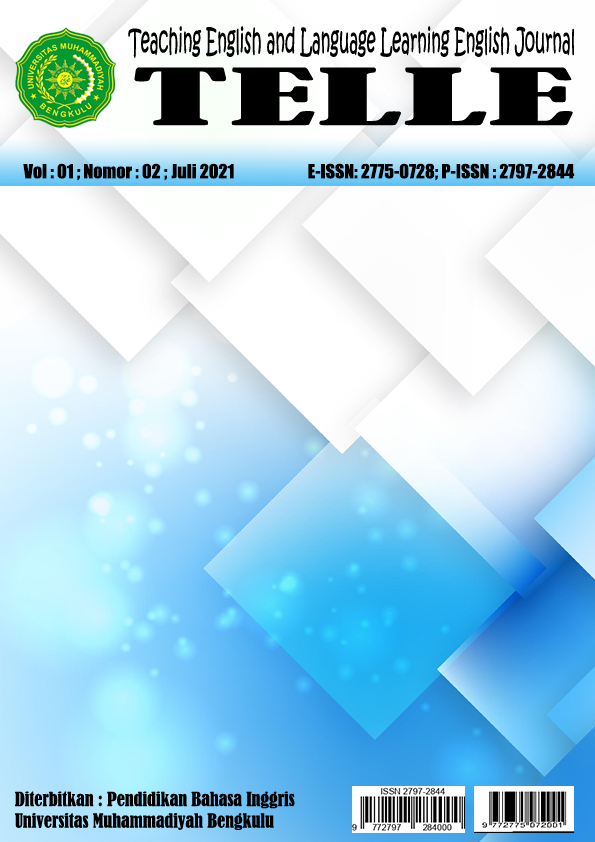The Ability of Students to Use an Android-Based Multimedia Learning Website Called "KELAS KITO" at Muhammadiyah University of Luring the Covid-19 Pandemic
DOI:
https://doi.org/10.36085/telle.v1i2.1897Abstract
This study aims to determine how the impact of the COVID-19 pandemic on students' ability to use E- Learning. This research uses descriptive quantitative case study method that is used to get a picture of students' ability to use E-Learning. In this study, the respondents were 30 students, and gave them a multiple-choice test. The results of this study indicate that the ability of students to use E Learning is sufficient, but there are some problems in using E-Learning cannot be accessed on certain Wi-Fi, and then the E-Learning web is often error. Therefore, it can be concluded that students already have the ability to use E-Learning KELAS KITO, but on the other hand, students also find some problems that exist in the E-Learning.
Keywords: Corona Virus, Online Learning, E-Learning KELAS KITOReferences
Abdillah, L. A., & Darma, U. B. (2020). Online Learning Menggunakan Zoom Teleconference. in Wan Hassan, W.A.S., Ariffin, A., Ahmad, F., Hamzah, N.,
Agung, A.S.S.N., Surtikanti, M.W., Quinones, C.A. (2020). Students’ Perception of Online Learning during COVID-19 Pandemic: A Case Study on the English Students of STKIP Pamane Talino. SOSHUM Jurnal Sosial dan Humaniora [Journal of Social Sciences and Humanities] Volume 10, Number 2, 2020 p-ISSN. 2088-2262 e-ISSN. 2580-5622 ojs.pnb.ac.id/index.php.
Alizadeh, Mitra. (2016). The Impact of Motivation on English Language Learning. International Journal of Research in English Education. Vol. 1. No. 2.
Alvarez, M.C (2001). A Professor and his students – Share their thoughts, questions and feelings. Paper presented at the American Educational Research Association Annual Meeting, Seattle, Washington.
Armstrong, Kimberly & Oscar Retterer. (2008). Blogging as L2 Writing: A Case Study. AACE Journal. Vol. 16. No.3.
Anggraini, Rezy, Yenni Rozimela, & Desvalini Anwar. (2020). Collaborative Writing in Writing Process: How Effective?. Social Science, Education and Humanities Research. Vol. 463.
Areej Al Shourafa. (2012). The Effect of Motivation on Jordanian 10th Grade Students' Writing Skill in English. European Scientific Journal. Vol. 8. No.22.
Ashrafiany, Hasanuddin, & Basalama, Nonny. (2015). The Students’ Writing Difficulties In Writing An Essay Based On Cognitive Process. Lingua Jurnal Pendidikan Bahasa. Vol. 16. No. 1.
Awada, Ghada & Ghaith, Ghazi. (2014). Effect of Using the Blog Educational Tool on Writing Achievement and Motivation for Legal Writing. International Journal of Education and Research. Vol. 2 No. 12.
Dessy Febyronita, Giyanto. (2016). Survei Tingkat Kemampuan Siswa Dalam Mengerjakan Tes Berbentuk Jawaban Singkat (Short Answer Test) Pada Mata Pelajaran Ips Terpadu (Geografi) Kelas Vii Di Smp Negeri 1 Mesuji Tahun Pelajaran 2015/2016. Jurnal Swarnabhumi Vol. 1, No. 1, Agustus 2016
Rubani, S.N.K., Zakaria, N. (2020). Students' Perceptions Of Using Zoom Meet Webinar During Covid-19 Pandemic In Technical And Vocational Education. Journal of Critical Reviews. ISSN- 2394-5125 Vol 7, Issue 19, 2020.
Silahuddin. (2015). Penerapan E-LEARNING dalam Inovasi Pendidikan. Jurnal Ilmiah CIRCUIT Vol. 1 No. 1 Juli 2015
Suadi. (2021). Students’ Perceptions of the Use of Zoom and WhatsApp in ELT Amidst Covid19 Pandemic. SALEE: Study of Applied Linguistics and English Education Vol. 2, No. 1, January 2021





